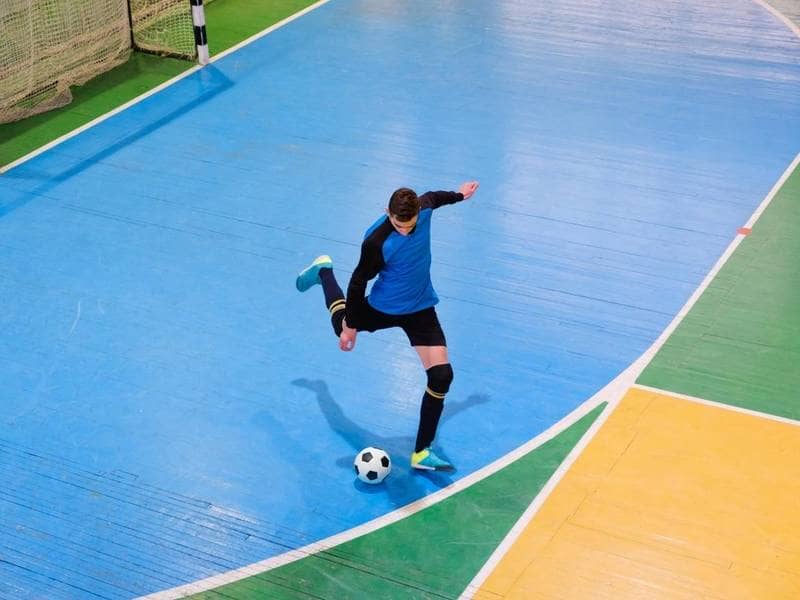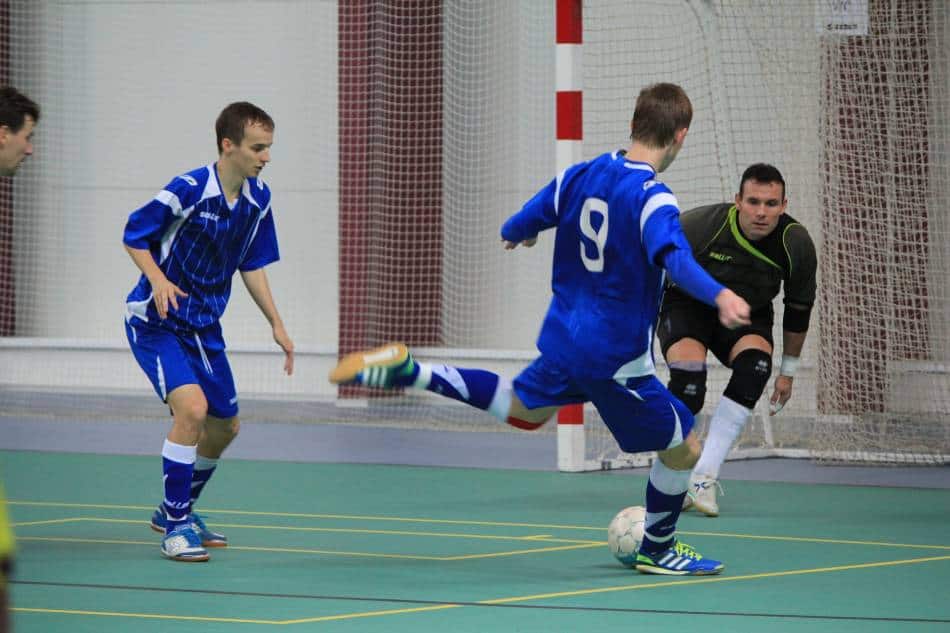
If you’ve ever ran outside with indoor soccer shoes before, we have something in common. I always figured indoor soccer shoes would work great for running around the block but I’m no longer sure that’s the case. Let’s find out by comparing indoor soccer shoes to traditional running shoes!
So can you run in indoor soccer shoes?
You can run in indoor soccer shoes but they shouldn’t be your first option. Indoor soccer shoes have a thinner sole than most running shoes, which translates to less comfort and shock absorption. The grip on indoor soccer shoes also wears down quickly by running outside with them.
While running outdoors with indoor soccer shoes isn’t the end of the world, you probably shouldn’t make a habit out of it. If you’d like to learn more about using indoor soccer and running shoes, we encourage you to read on.
Looking at the Soles of Indoor Soccer Shoes
Your typical running shoe has thicker soles and is usually more comfortable than your average indoor soccer shoe. Outdoor running shoes are built to absorb shock when running on harder services and pretty much on any other surface for that matter.
If you enjoy running for longer distances outside, especially if you do so on concrete, your back will thank you later for using traditional running shoes.
While indoor soccer shoes might do the trick for running outdoors, the shoes generally aren’t designed for this purpose.
Indoor soccer shoes will wear out faster when running on harder surfaces compared to your traditional running shoe.
This is because indoor shoes have tread patterns specifically designed for indoor and some outdoor surfaces. Using indoor soccer shoes on any other kind of surface will inevitably wear down the tread and make the shoes less effective for indoor soccer.
This means that indoor soccer shoes, which are already less comfortable and supportive than outdoor running shoes, will become progressively less comfortable and supportive over time.
Running outdoors with your indoor shoes will also lead to the grip wearing off the shoes. While this may not have a huge impact on running outdoors, it will affect your game when playing indoor soccer.
Indoor soccer requires all kinds of quick movements and turns, and not having that additional grip could lead to you slipping or turning an ankle.
Indoor shoes are durable in their own right but they are designed to have extra grip, so running outdoors on hard surfaces will remove that grip and will make the shoes less ideal for playing soccer.
Shoes designed for indoor soccer also have flat soles, while your traditional running shoes do not.
There are flat sole options for running shoes available, but most designs have arch support. Indoor soccer shoes have flat soles to help prevent injuries by providing a solid base.
Indoor Soccer Shoes – Arch Support

The main distinction between indoor soccer shoes and outdoor running shoes is that shoes designed for outdoor use typically have arch support. Indoor shoes don’t offer any arch support due to their flat sole designs. This means running outside on hard surfaces is going to be more comfortable with running shoes compared to indoor shoes.
There are minimalist running shoes on the market but they are more geared toward runners who are pushing their limits or run in races.
With indoor shoes, you’re likely to experience discomfort at a much quicker pace than regular running shoes. This is an important aspect to note as discomfort can reduce your will to run, which can lead to you running shorter distances than you would have otherwise.
Traditional running shoes are going to hold up much longer than indoor shoes when running outside and are going to be more comfortable.
Indoor running shoes might fit your running needs, but you’re most likely going to cycle through pairs at a higher rate than you would with normal running shoes.
Performance with Indoor Soccer Shoes
Indoor soccer shoes are designed primarily to be played on synthetic surfaces that you traditionally find in gyms but can also see use on outdoor and wooden surfaces. Compared to traditional running shoes, indoor shoes can be lighter or heavier, depending on your preference. The heavier the shoe, the more protection it likely offers.
Lighter shoes, on the other hand, forego extra protection for higher performance and more breathability. The extra breathability helps prevent your feet from overheating.
Indoor soccer shoes are also designed to be low to the ground to help you make quick movements and turns. The gum rubber soles on indoor shoes are a big proponent of quick movements.
This is an important aspect to note as indoor soccer is a much faster-paced game than its outdoor counterpart.
While traditional running shoes can work for indoor soccer, they shouldn’t be your first choice. Running shoes lack the extra protection of indoor shoes that are designed specifically to play indoor soccer. Blocking shots with regular running shoes wouldn’t be ideal.
Non-indoor shoes also don’t offer as much grip, making individuals more susceptible to ankle injuries. In comparison to indoor shoes, running shoes feel clunky.
They’re higher off the ground, don’t offer as much ankle support and protection in general, lack needed grip to play indoor soccer and more.
Indoor Soccer Shoes Based on Position

Within the realm of indoor soccer, some shoes are more favored than others because of what they can offer to a position.
For example, attacking players probably want to go for lighter shoes that offer better performance without sacrificing maneuverability.
You’re not going to block a ton of balls as an attacking player, so extra protection can be foregone to allow for greater performance.
Defenders on the other hand don’t want to sacrifice protection because they block a high amount of shots and taking more of a beating. Support is also very important for defenders due to the amount of lateral movement involved with playing the position.
Goalies should also opt for shoes that have additional support and protection. The position involves a ton of lateral movement and requires shoes that are capable of blocking shot after shot.
The type of material shoes are made out of also needs to be kept in mind before making a purchase.
Types of Indoor Soccer Shoes Based on Material
Leather
Flexible, soft, offers a natural feel and soft touch but stretches out quicker than other options.
- Suede leather: Traditional leather with the top layer removed, allowing for a softer touch.
- Kangaroo leather: Also referred to as k-leather, offers a soft touch and is incredibly comfortable. This type of leather is generally more expensive than the other leather options and isn’t available for purchase due to legal reasons in certain places such as California.
- Calfskin leather: A cheaper alternative to k-leather that still offers a soft touch and superior comfort. This type of leather is heavier than k-leather but doesn’t stretch out as much.
- Full-grain leather: This type of leather is thicker and more durable than k-leather and calfskin leather, while offering a similar touch to both of them. Compared with k-leather and calfskin leather, this is the heaviest option.
Synthetic
These types of shoes are made to be lighter, thinner and more durable than leather shoes. Synthetics don’t stretch out as much as leather shoes.
- Synthetic leather: Feels and plays like real-leather but the touch isn’t nearly as soft as real leather.
- Mesh: Thin, lightweight and has high breathability. Doesn’t offer as much support as traditional leather.
How do Shoes Impact Your Health?
In closing, I would say that if you plan to do a lot of running outside that buying shoes you can wear specifically for that purpose is probably the way to go.
Indoor soccer shoes can get the job done in a pinch but doing so will only wear them out quicker, which will force you into buying new shoes sooner. Running outside with indoor soccer shoes can also seriously mess up your back if you’re not careful.
If you plan to do a lot of running, you should get some traditional running shoes. There’s no reason to go out and injure your back needlessly by running with indoor soccer shoes.
Only having one pair of shoes might seem like the better and cheaper option but it will ultimately cost you more in the long run. By only having one pair of shoes, you’re more likely to get injured running (with indoor shoes) or playing indoor soccer (with running shoes).
You will also have to replace shoes quicker when you don’t use them for their primary purposes. Just something to keep in mind next time you’re looking at getting some new shoes!
Can You Run in Soccer Cleats?
You can run in soccer cleats as long as you’re running on grass. If you’re running on harder surfaces, it’s recommended you use a different kind of footwear.
